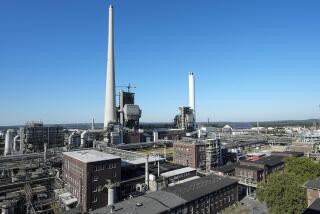In Adversity, U.S. Finds New Strength
- Share via
“Nature favors the hidden flaw” is a sardonic Murphy’s Law that might well apply to the suddenly mortal economies of Japan and Germany.
But for the U.S. economy, a corollary would be needed--”Stock market favors the hidden strength,” perhaps--to signify why stock prices continue to flout the conventional wisdom that the recovery will be “weak” or inadequate. Now flirting with 3,400 on the Dow Jones industrial average, the stock market is saying the recovery will be strong and sustained.
And the market is right, this recovery is different, says William A. Brown, chief economist at J. P. Morgan & Co. Most comebacks from recession kick off with rapid growth in consumer spending and replenishing of inventories. This time such growth is slow.
But there is a new pattern emerging, Brown says. The economy will be led by business investment in plant and equipment, which within six months will be growing at a 6% annual clip. Such investment will help the overall economy grow by a healthy 3% next year, a rate that will create jobs and banish much of the current anxiety.
That’s what the stock market is predicting--and other indicators support its optimism. Dataquest, the Silicon Valley research firm, sees 14% sales growth for semiconductors--the microchips that power computers and thousands of other products. That means U.S. investment in computers and related equipment will be strong.
And by early next year, investment will be increasing in machine tools and industrial processes, promising a strong pickup for a large swath of U.S. industry--firms such as Giddings & Lewis, Cincinnati Milacron, Duriron, FMC, Nordson, Parker Hannifin and many others.
An important shift in capital costs is behind the improved outlook. More complex than simple interest rates, cost of capital is the term business uses to denote the total cost of financing a company through borrowing and issuing stock. Capital was much more expensive for American firms than for companies in Japan or Germany during most of the 1980s--a key factor in U.S. uncompetitiveness.
But in the early ‘90s, capital costs have come down 30% for U.S. companies while they’ve risen for Japanese and German firms.
U.S. costs have fallen for a variety of reasons--including the recession’s effect on interest rates. But a major factor has been adversity: High capital costs forced U.S. companies to restructure finances, borrow less and cut operating expenses. They also invested less in plant and equipment--totals fell last year.
But investment is recovering this year and will grow more rapidly in 1993. Adversity has brought forth hidden strength.
Meanwhile, others are confronting hidden flaws. In Japan’s sky-high stock market of the late ‘80s, companies raised money at an effective cost of 1%. Such “free” money lured companies to invest billions in plant expansions.
Now, however, there is massive overcapacity and the plants are not yielding a profit--just when the stock market has fallen, banks are in trouble and Japan’s companies are expected to show a profit and pay dividends to all those shareholders who bought stock at high prices.
The effects of the turnabout are widespread. For instance, Japan’s computer industry is troubled and restructuring, reports technology expert Sheridan Tatsuno in his newsletter NeoJapan. The computer makers grew careless in the cozy atmosphere of Japan’s industrial groups, called keiretsu.
“Within their protective keiretsu , they’ve been able to sell overpriced systems to captive customers,” writes Tatsuno. “But now the customers are demanding multi-vendor environments. They’re tired of paying for lousy price-performance.”
Germany’s successful Western economy also enjoyed hidden protection as long as the Iron Curtain kept East Germany separate and uncompetitive. But with unification have come costs and tensions as several million lower-paid Easterners have joined the German work force. Former West Germans don’t want to pay taxes to help the newcomers, but do want to keep their $25-per-hour pay levels and wage growth far beyond productivity gains.
The result is that Germany today is wracked by strikes and forced into a high-interest policy that threatens all the economies of Europe.
One point for Americans to keep in mind is the flimsiness of economic forecasts: Only yesterday, Japan and Germany were praised as unbeatable and incomparable by experts who missed their hidden flaws. Now both are coming into the real world.
But Americans also shouldn’t delight in the misfortune of others. It’s a loser’s attitude--and also unwise.
The long term looks good for Japanese companies, which will benefit from adversity as U.S. business has. And Germany surely will benefit from unification. Already Berlin is building a center for corporate headquarters in the no-man’s land where yesterday stood the wall and Checkpoint Charlie.
Meanwhile, it’s satisfaction enough that American companies can leave behind a long period of pessimism and uncompetitive capital costs and invest with confidence once again.
An Important Shift
The cost of capital--the price a company pays to finance its business, through borrowing or issuing stock--was significantly higher for U.S. firms than for Japanese companies in the late ‘80s. Now those cost comparison are reversed, improving the outlook for U.S. firms but casting shadows in Japan. The cost of capital in percent
1987-89 U.S.: 7.8% Japan: 5.2%
1992* U.S.: 5.4% Japan: 5.9% *January through March Source: J.P. Morgan & Co.
More to Read
Inside the business of entertainment
The Wide Shot brings you news, analysis and insights on everything from streaming wars to production — and what it all means for the future.
You may occasionally receive promotional content from the Los Angeles Times.








